10 Million Users And Rising Fast: Sri Mandir's Quest To Put A Temple In Every Phone
What happens when an elite team reimagines devotion for the smartphone age? We examine the product, business model, and impact of a category-creating startup built for India's billion Hindus.

Hi, it’s been a while.
It certainly has. Eighteen months to be precise. But…
And I am very excited, because it feels like India is exploding right now. Air India just placed the largest aircraft order of all time. Vedanta and Foxconn are setting up a semiconductor manufacturing facility in Gujarat. ISRO and the Indian spacetech industry keep banging out next-level rockets and satellites. Every week, it seems like we inaugurate a new high-speed train line or airport. Our stellar public digital infrastructure continues to grow and inspire the world. Indian films and content are smashing box offices and winning over audiences the world over, not just in Hindi but in a plethora of languages. Back at home, the fine arts and music seem to be going through a similar renaissance, with incredible art exhibitions and concerts on the regular (The Strokes played in Bombay!).
You might (correctly) allege that my unusually optimistic viewpoint omits several very real problems, but in my eyes, this country’s energy and excitement for the future are palpable. The startup ecosystem, in particular, seems to be at the eye of this Indological storm. And I love that; after all, we started Tigerfeathers with the purpose of sharing inspiring stories from the Indian tech and business scene. Stories that leave you impressed and informed. Stories like that of Sri Mandir, the protagonists of this article.
But before we dive in to Sri Mandir, I’d just like to say thank you. Whether you are a returning subscriber or a new visitor to this site, we appreciate your attention, encouragement, and feedback 🙏🏽 🙏🏽 Subscribe, share, and stick with us because we have some extremely high quality content in the pipeline 🇮🇳⚡
Alright so Sri Mandir - what is it?
“We want to impact 100s of millions of people. Our impact appetite isn’t just to serve 5 or 10 million people.” - Prashant Sachan, founder, AppsForBharat
Sri Mandir (meaning ‘honoured temple’ in Hindi) is an Android app developed by a company called AppsForBharat. Just like the image above, it is simultaneously traditional and futuristic. On one hand, it feels very nostalgic and familiar. But paradoxically, it also feels new and unlike anything we have ever seen before.
I wanted to write about this company for two reasons. Firstly, I was extremely intrigued by their product - I had never seen anything like it before. Secondly, Sri Mandir feels to me like an emblem of the new India - starkly aware of its roots and history, but with an eager eye towards the future. It is highly ambitious, and completely unafraid to forge its own path. This is not an app which is cloning a foreign product or business model for India. This is a completely new beast, which has been designed in India for India. And I think that is worthy of closer inspection.
So here is what we will cover in this piece:
Sri Mandir’s fascinating origin story (it was spun out of a soonicorn startup 🤔)
An overview of India’s massive religion and devotion market 🕉️
A deep dive into the Sri Mandir product, UX, and business model 📱
A look at the traction, investors, and trajectory of Sri Mandir going forward 📊
My views on the business and some lessons we can take away 🛠️
Without any further ado, let’s get it.
Hold up - are you sure about this? Religion is a world away from tech. Is this really a topic worth covering?
I’m glad you asked. Over the past few weeks, I’ve received quizzical looks from a number of tech founders upon telling them that I’m writing about an app for Hindus. Their raised eyebrows convey a dismissive attitude towards this industry, but I think it’s important to set the record straight. This is 100% a topic worth covering, for a number of reasons:
Religion has a gigantic human footprint - it offers a foundational connection to the lives of billions of people the world over. There is no reason technology should not be leveraged to augment and improve that connection. It would be a moralistic overreach to presuppose that faith isn’t worth the attention of technologists.
For the reason outlined above, the business of religion is also absolutely massive. In India alone, the market for religious spending is estimated to be around $50B annually. He who scorns and dismisses this fact ignores a multibillion dollar industry with deep profit pools.
Trailblazing products like Sri Mandir definitely introduce new user habits, but they also accentuate existing mindsets and behaviour patterns. These are useful insights which can help inform a new generation of products designed to serve a very large target audience.
Let’s dig deeper into each of these points, with a particular focus on the Indian context.
1. Religious People != Few. Religious People == Many.

There is a sort of implicit assumption in some circles that the importance of religion is slowly decreasing with the passing of generations. The data paints a different picture - it shows that religion is still hugely important to a large majority of the population. This clip from Shark Tank India is a fitting rebuttal to this assumption - Aman Gupta’s quintessentially Indian shrug at the end of the exchange says it all really (my translation for non-Hindi speakers).
In a religious country populated by 1.4 billion people and a growing base of 850M Internet users, there is still a lot of headroom for religious expression in tech. Consider this - with 58M subscribers, T-Series Bhakti Sagar (a Hindu devotional content channel) is the tenth most subscribed YouTube channel in India. It is also the twenty-fourth most subscribed YouTube channel in the world. But the raw numbers and size aren’t the only takeaway here - the intensity of religious feeling must also be accounted for, too.
As the above infographic from the Pew Research Center shows, around 84% of Indian adults believe religion is very important to their lives, and around 60% of them say they pray every day. That is an extremely high level of religiosity! It’s amongst the highest in the whole world according to this older Pew study from 2006-2017. It’s certainly much higher than every single country in North America, Europe, and East Asia (barring Indonesia).
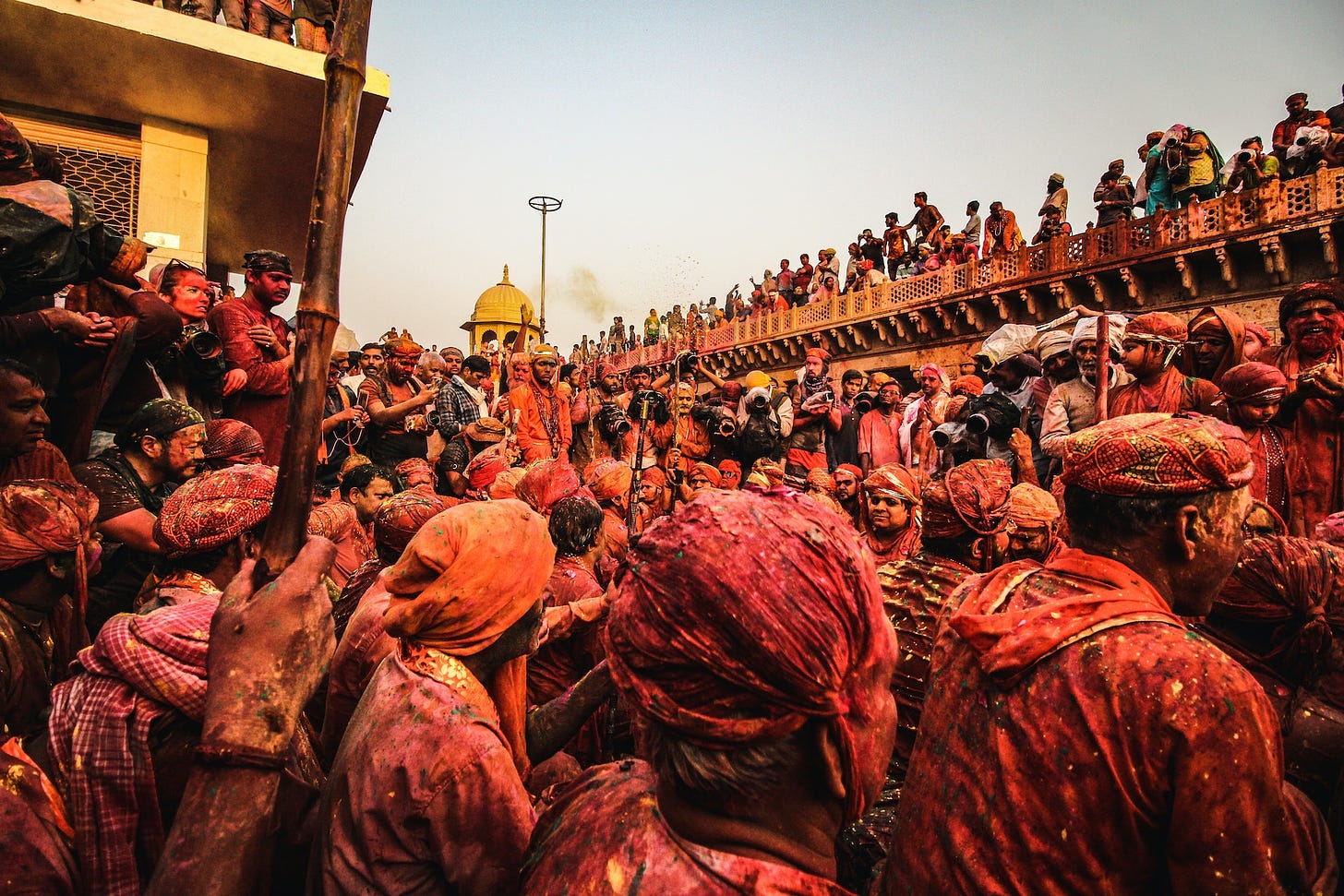
The writing on the wall is clear - religion matters a lot for a great many people, and there is no reason for builders to shy away from this reality. Yes, matters involving faith and religion must be handled more sensitively than other issues, but imagine the quantum of convenience, utility, and happiness that can be created with the thoughtful application of technology.
Consider the Shark Tank clip once again; Hoovu - the company pitching in that video -is a D2C company which uses technology to increase the shelf life and accessibility of Hindu ritual offerings like flowers and incense sticks. The sharks practically clambered over each other to offer private deals to this business, before eventually agreeing to present a joint offer to the entrepreneurs.
And for good reason - the addressable customer base is gigantic. Just because certain interpretations of faith or tradition may occasionally clash with certain principles of science does not mean that technological progress in the realm of religion should be seen as contradictory, exploitative, or undesirable. On the contrary, it can create a lot of human happiness and peace. And yes, it can also be very lucrative.
2. Religion is big business. Very big business.

These numbers say it all. In a world in which temples and festivals can pull in revenues of billions of dollars, it stands to reason that forward thinking entrepreneurs can also carve out opportunities for themselves.
And this has not gone unnoticed by the world’s capitalists. Several financial and strategic investors have already plowed money into this category. Globally, apps like Hallow ($50M raised from Peter Thiel, Softbank, Drive Capital) and Glorify ($50M raised from a16z, Kardashians) have pulled in famed investors to build daily-use prayer and meditation apps for Christians.
The same thing has happened in India, albeit to a lesser extent. With $15M raised, AppsForBharat is the most well-funded faith-tech startup in the country. The parent company of Sri Mandir counts amongst its backers the following investors: Elevation Capital, Sequoia Capital, Beenext, WEH Ventures, Mirae Asset, the Sharechat founders, the Meesho founders, Anupam Mittal (shaadi.com), and Kunal Shah (CRED) just to name a few.
But there are numerous other VC-backed faith-tech startups such as AstroTalk, VAMA, Paavan, and the aforementioned Hoovu. All these players have different niches, but they all go after the gargantuan spending pool of Indian devotional needs.
The bottom line is that there is serious revenue potential here. AstroTalk, for instance, claims to be the world’s largest astrology company with a revenue run rate of around 300Cr ($~36M) a year. They also claim to have sizeable profits, so I guess that’s the bottom line squared? Terrible jokes aside, to ignore this category would be to dismiss a large part of the economy.

3. We can learn a lot about product-building from the faith-tech industry
With over 10M installs, Sri Mandir boasts a statistically significant sample size of people in the communities it covers. The data from this cohort is fascinating and can help bring to life many of the lived realities of this country’s inhabitants.
For example, I learned from Sri Mandir that they see daily usage start picking up at 4am before peaking around 7am. Clearly, many people in India begin their day extremely early with a moment of prayer. How often did you stop to think about this behaviour pattern at population scale? Are there hidden opportunities to serve the numerous consumers who spend the dawn hours in prayer or meditation? Are they in need of space, food, material, company, or transport? By examining the data from apps like Sri Mandir, we can ask telling questions that might yield useful answers.
In a similar vein, the UI/UX and interaction design from faith-tech apps can also teach us a lot about product design and user behaviour. Sri Mandir has remixed many conventional app design guidelines in order to shape behaviour for their exclusively Indian-language user base. We will look at some examples of this in a later section of the article, but I truly believe that the lessons learned from faith-tech are highly valuable for understanding the psyche of hundreds of millions of Indians, particularly those outside of the major cities.

OK we get it: ignore faith-tech at your own peril. Now tell us about Sri Mandir, babbler.
“I am an internet entrepreneur based out of Bangalore in India, and I have an ambition to impact 100s of millions of lives everyday through the technology we create.”
Alright. Let’s talk about Sri Mandir. We’ll start with the founder, Prashant. The quote above - lifted from his LinkedIn bio - tells you everything you need to know about the guy, but his personal story and the founding tale of AppsForBharat are important, so we’ll briefly cover those.
Roll your clock back to the Kanpur district of Uttar Pradesh in the 1990s. This is where the Sri Mandir founder, Prashant Sachan, was born and brought up in an agrarian family. All of Prashant’s four uncles were farmers, but his father - a technician with HAL - was the odd sibling out.
Prashant never felt like he had a particularly tough life while he was growing up, but looking back at things, he admitted to me that his family actually went through a lot. Medical issues, in particular, were a cause of stress for the Sachan family.
To help tide themselves over in these stressful times, the family looked to God. Both of Prashant’s parents were devout followers of Hanuman, and Prashant remembers them leaning on their faith to give them the strength and peace to navigate the dark days. This experience of religion would be seminal in Prashant’s future decision to build Sri Mandir.

After studying mechanical engineering at Uttar Pradesh Technical University, Prashant immediately dove into a Masters of Design (Interaction Design) at the Industrial Design Center in IIT-Bombay.
Armed with this new knowledge of interaction design, Prashant worked for two large multinational tech companies as a product designer - first with Samsung, and then with Microsoft. Prashant’s stint with Samsung would be particularly influential - during Prashant’s time working with the Korean giant, they were planning to launch their own competitor to Whatsapp called ChatOn.
In order to better study the market for Android instant messenger apps, Prashant extensively interviewed and researched consumers across numerous Indian towns. His team at Samsung eventually concluded that there was a lot of potential in the rural Indian market; this helped Prashant realize that his own family was actually very representative of the rest of the country, and that they could be an invaluable reference point while building for Bharat.

The first serious entrepreneurial venture of Prashant’s career was a short-lived collaborative decision making tool for e-commerce buyers that he launched in between working at Samsung and Microsoft. However, the first time he tasted scale as an entrepreneur was at his next venture - Trell.
In 2016, Prashant teamed up with some fellow IIT-Bombay alumni to co-found a video-based social commerce app called Trell. Over the next few years, Trell would go on to leave a mark in the startup ecosystem, amassing a reported user base of 68M and raising more than $60M from the likes of Mirae Asset, H&M, Fosun, and Sequoia Surge. The company would also eventually run into issues with ‘financial irregularities’, but Prashant had already left by then (Prashant left in mid-2020 and the first reports of issues at Trell came out in mid-2022).

According to Prashant, he left due to a difference of opinion with the other founders. But when he exited the company, he didn’t leave Trell behind altogether. That’s because Prashant actually started working on Sri Mandir while he was still at Trell.
You see, many of Trell’s users came from tier 2 and tier 3 towns in rural India. Prashant wanted to experiment with different apps and products that could be cross-promoted to these users, so he set up a venture studio within Trell. With a small group of designers and engineers, Prashant would hack together simple apps built for the Trell user demographic. He called this studio AppsForBharat.
Out of all of these apps, one of them stood out in terms of its popularity and user retention - an early prototype of Sri Mandir. This was a lightbulb moment for Prashant. He had been thinking about the most important concerns in the lives of the next billion Indian smartphone users, and his own lived experience made him think of religion. Prashant realized at that moment that he might be onto something, and he decided to set off on his own to pursue it. But because he had first come up with the idea while working at Trell, he was obligated to grant his former employer some equity in his new venture - this came out to around 17%. Thats how Sri Mandir was actually spun out of a soonicorn startup.
OK that’s actually an interesting story, now how about you tell us about the product itself?
Gladly. But why tell you when I can show you instead.
When you open the Sri Mandir app, the first thing you see is your own personal shrine to God. As the demo shows, there are multiple Hindu deities featured on the platform, and users can toggle between them. For each deity, there are also multiple avatars that the user can swipe through until they find one that resonates.
Once the user settles on a shrine setting, they can perform a highly interactive virtual arti (prayer) to their God or Goddess of choice. This involves lighting of the arti jyot (lamp), ringing of the mandir bells, blowing of the conch, and circulation of the arti thaali (plate) around the deity.
Users can also conduct ritual offerings to their deity of things like digital flowers, leaves, Gangajal (holy water), garlands, and other unlockable items. While doing all of this, users have access to a slick inbuilt audio player which is loaded up with thousands of songs, mantras, chalisas, bhajans, and other devotional tunes dedicated to various immortals of the Hindu pantheon.
This is the main feature and single hook of the Sri Mandir app - it allows you to offer virtual prayers to your Gods in much the same way as you would do in your home temple. Except Sri Mandir lets you do this anytime, anywhere, right from the convenience of your phone. There are many more facets to this app, but this one feature is central to the whole agenda.

So who is using this product and how is it doing?
The product is available in Hindi, Marathi, Gujarati, and Rajasthani. Three more languages - Punjabi, Bengali, and Odia - are coming soon, but for the time being it’s just these four.
So the people using this are Hindus from those linguistic communities. And there are a lot of them - millions, to be precise. Sri Mandir has over 10M downloads, with 3M MAUs (monthly active users). So it’s already massive. In terms of age demographics, the user base is very diverse but there is significant representation in the 40-60 year old category.

Interestingly, many of the app’s users come from foreign countries like the US, Singapore, Europe, and Nepal (unsurprising given the religious and linguistic overlap). Sri Mandir says they have never marketed outside India - so this is all organic pull from people who love the app and share it with their close ones. And judging by the rating on the app store, you would certainly believe that claim: Sri Mandir has an absolutely stonking rating of 4.9/5 across ~100K reviews.
So you would say its doing pretttty damn good so far, especially considering the app has barely been in the market for two years.
That is indeed stonking, but how does the company make money?
Sri Mandir is very early in its monetization journey, but they already have an annualized revenue run rate of $1M+. This revenue is coming mainly from two services: chadhava and e-puja .
To start off, let’s look at chadhava. This service allows users to make physical ritual offerings at famous temples all across the country - it’s separate from the virtual chadhava that is done with digital offerings on the shrine page of the app. Currently, Sri Mandir supports temple complexes in several holy cities including Ujjain, Haridwar, Vrindavan, and Varanasi.
With the click of a button, users can choose a famous temple in one of these locations - say the Kashi Vishwanath Temple in Varanasi for example - and select a basket of offerings they wish to profer in said temple. These offerings include things like flowers, peacock feathers, ghee, and several other items relevant to that particular temple tradition.
Once the user has selected their basket, they complete a payment and are rewarded by the dopamine-inducing sound of a temple bell ringing (more on this later). From that point on, the Sri Mandir operations team takes over and arranges for priests at the chosen temple to receive a physical packet comprising the user’s chosen offerings.
The priest then conducts a prayer to the given deity, making sure to individually name each user who contributed an offering. Lastly, the priest travels to the sanctum sanctorum of the relevant temple and places the user’s offerings in the shrine. This entire ritual is filmed and sent to the user (except the sanctum sanctorum part because cameras aren’t allowed there). At each step of the process, the user can check the progress of their offering on the Sri Mandir app or by interacting with the Sri Mandir Whatsapp bot.
During the course of my research, I actually used this service multiple times. Here are some of my pictures and videos from the experience. Scroll to minute 0:57 to see the priest call out my name in the video.

While they form the crux of the chadhava service, temple offerings aren’t the only things available to users. On festive occasions, Sri Mandir will pull something special out of the bag. For example, the company ran a Diwali campaign allowing users to light diyas inscribed with their family’s names in Ayodhya. Just imagine how happy that would make your nani and dadi.
In addition to chadhava, Sri Mandir also has a service known as e-puja. The premise here is that organizing a full-fledged puja (prayer ceremony) with Vedic priests requires considerable effort, space, and money. The cost estimates for a private puja vary from Rs. 10K-30K. Sri Mandir makes this process cheaper and more convenient by aggregating users into single bloc.
That means that five families who wish to conduct a Dhan Teras puja costing Rs. 15K total can come together and go ahead by paying only 3K each. Just like in a normal puja, the priests in an e-puja recite the names of the family members and make offerings on their behalf. All of this is filmed and sent to the users along with some of the puja prasad. In both this service as well as chadhava, Sri Mandir’s business model is to layer a fee on top of the user’s payment.
Thus far, hundreds of thousands of people have used these two services, and the early traction looks very promising. But that isn’t all the Sri Mandir team has in store; in the future, the company intends to experiment with other monetization avenues including gifting/donations, digital goods/avatars, and more.
One of the most promising of these ideas has already been rolled out to a few users - it’s a sachet-sized subscription service. For as little as one rupee per day, users can take part in guided prayer regimes, meditation programs, or religious discourses. With its 2 million paying subscribers from Bharat (!), the smartphone-based audiobook company Kuku FM has already shown that subscriptions can be a high-scale product in India, so this is one space to watch closely.
Frankly, I think there are a bajillion more things the company could do that neither they nor I have thought of yet. Just imagine the opportunities that lie in store for a business that can tap into the religiosity and daily habits of hundreds of millions of people. But just because these opportunities may exist doesn’t mean that they should all be pursued - the Sri Mandir team goes to great lengths to emphasize this.
According to Prashant, a trip he once made to China taught him to think in terms of ‘transaction-first’ and ‘engagement-first’ business models. In a transaction-first model, most of the customer LTV (lifetime value) comes up front. The companies employing this model usually try and push customers into making a transaction as soon as possible. Think of classifieds sites or online marketplaces.
In contrast, engagement-first business models are those in which the customer LTV trickles in over a long time period. In order for that to happen, the customer has to keep coming back to the app in question over a period of time. Like Instagram or Twitter, the business must keep people continually engaged and refrain from turning them off - in other words, building trust is paramount.
That is why Prashant wants to take it easy with the monetization levers. He doesn’t want to show the users any ads or make them feel like a sale is being forced down their throats. For this reason, Sri Mandir also waives the transaction fees on the first few chadhavas a user conducts.
Pretty dope. Are there any other things about the app we should know?
While the ‘virtual shrine in your pocket’ is the one primary hook of the product, there are a host of other features as well. These include Hindu daily horoscopes, astrological chart readings, livestreams of various religious activities and temple services, and a repository of religious content. On the audiovisual side, the app links to various YouTube videos of Indian TV shows about gods and mythology. On the literary side, Sri Mandir contains passages from the Bhagavad Gita and other holy texts.
The app also has a social component - there are a lot of readymade images, greetings, and quotes that are optimized for sharing on Whatsapp. There is also a section in which users can join specific Hindu sub-communities and share, like, and comment on each other’s posts.
Over and above the other product features of the app, there is something else I want to highlight here - some users of Sri Mandir report that worshipping via the app makes them feel more esteemed than worshipping in person does. One aspect to this is that Indian temples are usually incredibly crowded. You have to jostle in a throng of people to make it to the inner shrine, and you are often hurried along your way once you get there. It can be jarring to spend hours waiting in a queue only to be impersonally herded past the sanctum sanctorum without getting a moment to drink in the experience. Sri Mandir helps users get a more personal flavour of worship - one in which the priests can read out the worshipper’s name loudly, clearly, and with reverence. If you go through the Play Store reviews, you will find that the elevated level of respect and individual attention that users are accorded is something that sits well with the people.
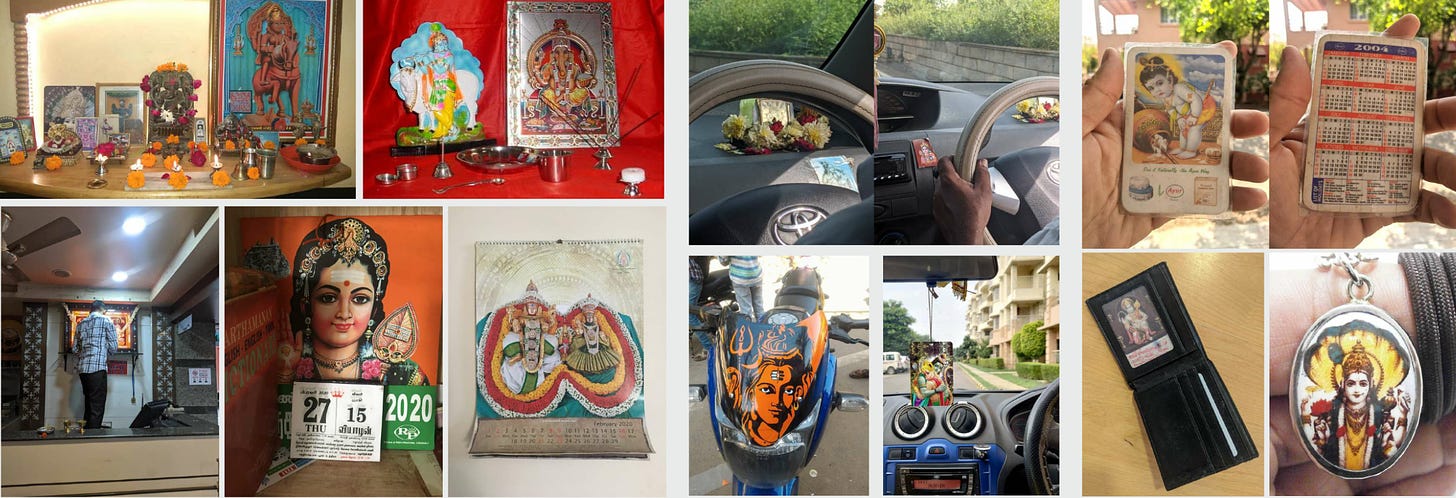
Hmm is this app only for Hindus or are there other religions too?
Sri Mandir will always remain an app only for Hindus, but Prashant has stated that he wishes to build products for other religions in the future. For the time being however, there is still a lot of work to be done on Sri Mandir. I imagine that high up on the priority list is the inclusion of more regional languages and communities, especially those from the fervently religious South Indian milieu.
What are some of the pitfalls or challenges this business might face?
Sri Mandir seems well equipped to surmount the normal hurdles faced by consumer internet companies, namely customer acquisition, user retention, and monetization. They’ve demonstrated organic growth, high repeat usage, and strong spend propensity. Their problems might be of a more… unusual nature.
For a start, India’s complex internal idiosyncrasies could prove to be a stumbling block. Hinduism is not a monolithic religion; it has many different interpretations from one community to the next. To make things trickier, people can be very protective about how their faith is portrayed or utilized. A slight misstep in the product presentation or marketing messaging and there could be serious consequences.
The company could also find itself in trouble through no fault of its own; every groundbreaking business model that attracts a lot of glamour and revenue naturally becomes an object of ire and jealousy. There is a nonzero risk that vested interests may try to exert pressure by claiming that Sri Mandir somehow violates a law or custom. Personally, I think such a claim would be unlikely to succeed. We do have a sensible judiciary, and I think they would give the product a fair review on the basis of its merits.

Another question that must be raised is the response from temple authorities - it would be presumptuous to assume that they will accommodate all of the company’s wishes. I recently heard a story about an e-commerce startup that used to harvest prasaad from famous temples and sell it online. Apparently this company caught flak when the authorities at a large temple accused them of falsely portraying themselves as official and preferred partners of the temple. Ultimately, the company had to scale down significantly under the pushback.
This is a real concern for faith-tech apps wishing to conduct operations with big temples, but I think that Sri Mandir will have a very favourable negotiating position compared to the startup I allude to. Most crucially, Sri Mandir have their own distribution. They have 10M users already - they can make a very compelling argument that they can boost the income of both priests and temples. In contrast, the e-commerce startup did not have anywhere close to that kind of traffic or user pull. Sri Mandir could even theoretically build their business without needing to interface any temples at all. At the end of the day, their primary hook is a personal virtual shrine which they will always retain complete control of.
So where is this going? What do you think about the company, Aaryaman?
Considering the fact that I spent weeks researching this company and industry, it’s fair to say that I think this is a really big deal. For one thing, the product design just blows me away.
A young software engineer I spoke to said that the shrine section looks like it was built using the technology and aesthetics of late 90s webpages. I don’t really disagree, but I think that’s the point. The app feels simple and easy to use. The imagery is familiar and comforting. And crucially, the product yields a constant flow of positivity, calm, and dopamine.

The entire process of logging in and worshipping is gamified and tweaked to make users feel good. The first thing you hear when you open the app is the stirring tungg of a temple bell. Each successive day that you conduct an aarti or use a feature, you get some karma coins that can be redeemed for rare digital ritual offerings and free astrology consultations. Speaking from experience, it feels good earning these coins - they make a very satisfying clinking sound as they are added to your purse.
Most of all, the aarti itself is extremely powerful - the act of physically moving the plate with your finger is somehow psychologically rewarding and calming at the same time. Even the tutorials are extremely finely crafted to help those who may be older, less tech-savvy, or in need of a hand. Consider this video that is sent to users as a Whatsapp message upon completing a chadhava transaction.
These guys clearly know how to educate, guide, and treat their users well. The numbers back this up - the usage patterns show strong signs of habit formation and repeat use. According to the company, a user who tries out a feature in a given week is almost twice as likely to reuse that feature for 7/7 days in that week than they are to use that feature only once. This is a very strong testament to the accessibility and allure of features like virtual aarti, astrological calendars, community feeds, and holy texts.
Additionally, the team tells me that almost 20% of the revenue for the chadhava service comes from less than 2% of the chadhava users. This is a striking statistic that echoes the whale-like behaviour of power users in the mobile gaming industry. These are eye-popping figures, and I think that a lot can be learned from Sri Mandir’s approach to product building. Especially for those serving the Bharat demographic.

But is it a good thing that this app seems so addictive?
That’s a really good question. The capitalist in me says an immediate yes. I can’t deny that I would love to own shares in this company. On that point, let me just clarify that I don’t have a stake in the company and I haven’t received any kind of payment to write this. I just think this app is going to become a sensation and I want to write the best article on the topic that people will always refer back to when discussing it (it’s already a sensation for heaven’s sake, 10M users!).
On the other hand, the techno-optimist in me is a little more unsure. For most of my life, I haven’t been religious. In fact, young Aaryaman was once an argumentative little atheist. My wagon has long been hitched to the train of scientific progress and humanism. I can appreciate the argument that there are nobler pursuits than digitizing religion. Pursuits in fields such as education, healthcare, energy, and financial inclusion.

To go even further, you could even build a case that something like Sri Mandir is in fact immoral. After all, the product is intended to make a profit by enticing users to make lucrative transactions and offerings in their search for religious fulfilment. The early signs do suggest that certain users are getting addicted to the product. So I can see how some might argue that Sri Mandir is actually building toll plazas on a digital superhighway of money flowing from the people to the temple establishments.
But in my opinion, this way of thinking has big flaws. For one thing, it makes several problematic moral implications. Chiefly, it assumes that on some universally established moral scale, religion is not high enough. Obviously, no such scale exists, and it is sanctimonious to assume otherwise. Sure, we may be able to unambiguously agree on certain ideals such as health, safety, nonviolence etc., but where do we draw the line? Should things like sports and entertainment be denounced because they don’t directly contribute in some way to the progress of our species? Faith means different things to different people - for some people, it might be a source of hope and succour against the harshness of the mundane world. For others, it can offer a sense of belonging, of feeling like they’re a part of something greater than themselves (think of the expats living far away from home). Hell, this sounds a lot like how supporting Liverpool FC makes me feel. Does that mean it’s wrong? Please don’t tell me its wrong (it’s not).
Secondly, the case against Sri Mandir negates the agency of the users themselves, who are willingly using the Sri Mandir app. Presumably, they are doing this because it gives them some relief and comfort, so why would that be wrong? Even if there is some induced demand to spend more time and money on Sri Mandir because of the newfound convenience it offers, it is still the user’s choice at the end of the day. The same user could find many ways to spend on religion outside the app. Moreover, what’s the difference between a user who spends on faith-tech versus one who transacts in the realms of ecommerce, shopping, or videogames? Couldn’t you make a counter-claim that a user spending hours on Sri Mandir is making a better use of their time than someone on Netflix or Dream 11? Clearly this line of reasoning opens an unseemly can of worms.
The case made thus far has also assumed that religion has no educational or psychological benefits and is somehow mutually exclusive with science. This is not the case - there is much to be learned, celebrated, and cherished about religion. It can teach us to be contemplative and equanimous in the face of life’s many mysteries and tribulations. For all it has given us, science still can’t disprove that we aren’t all just brains in a vat anyway. If we want to choose our own responses to the unanswerable questions of life, so be it.
OK this just got weird and philosophical, do you want to maybe wrap this up now?
Sorry. And yes, that’s probably a good idea.
I set out to write this because I saw something powerful in Sri Mandir. I saw the makings of a large and interesting business that you’ll probably hear a lot more about soon, but that wasn’t all. I also saw a beautifully effective product that is refining the playbook of building for Bharat. Driving this, I saw an inspiring and talented team with a monstrous appetite to touch lives and spread happiness.
But most of all, I saw India in flux.
Yes, we now indigenously develop world-class fintech rails and cutting edge spacecraft. We produce talent that helms the world’s biggest tech companies and shapes the global trajectory of machine learning.
But for all this futurism and tech-forwardness, it is our culture that makes us who we are. This country has a ridiculously rich and beautiful heritage. Our history, mythology, and religions keep us moored and give us a unique perspective.
For the first time, I’m seeing them come along with us as we march into a mysterious, computerized future. And I think that’s pretty cool. I hope you do too.
About the author: Aaryaman grew up in Bombay and graduated with a history degree (specializing in Indian history) from Columbia University in NYC. He is also a wannabe engineer, 2x entrepreneur, and the founder of an early-stage fund called Prophetic Ventures. By luck or through curiosity and persistence, he has contributed in a small way to the remarkable IndiaStack project. His current focus is creating great content on Tigerfeathers and financing cool people/companies/ideas for India. If you think there is a potential Tigerfeathers subject or investment opportunity worth sharing, or if you’d just like to say hi, you can reach out on Twitter or aaryaman@prophetic.ventures.
Opportunities: There are loads of job openings at stellar Prophetic Ventures portfolio companies. Email Aaryaman with your CV/bio to be connected with one of the companies below, or many other high-quality startups not mentioned in the list.
An insanely impressive Series A-funded electric vehicle company (specializing in battery swapping) is looking for finance and business talent to help them as they embark on a rapid scaling journey.
A large agricultural fintech innovator is looking for folks across product, engineering, and finance. This company is a soonicorn which is making a high impact on hundreds of thousands of farmers across the country. Soon to be millions.
A highly profitable fintech app serving young Indian borrowers is looking for executives to handle regulatory relationships. Part-time and advisory roles also work. The company has its own NBFC.
Thank you for reading and see you soon! 👋🏽 🇮🇳 🐅






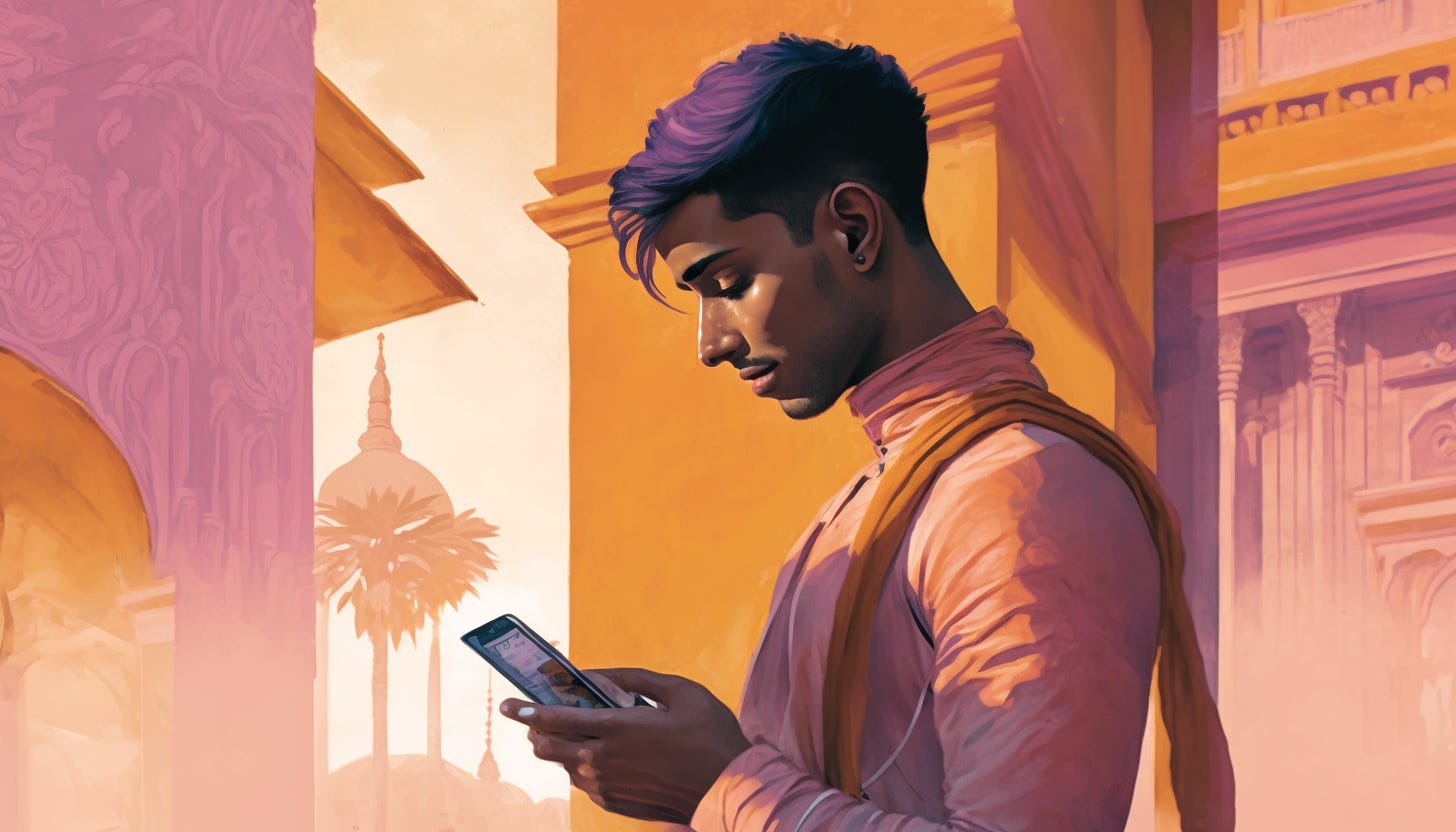


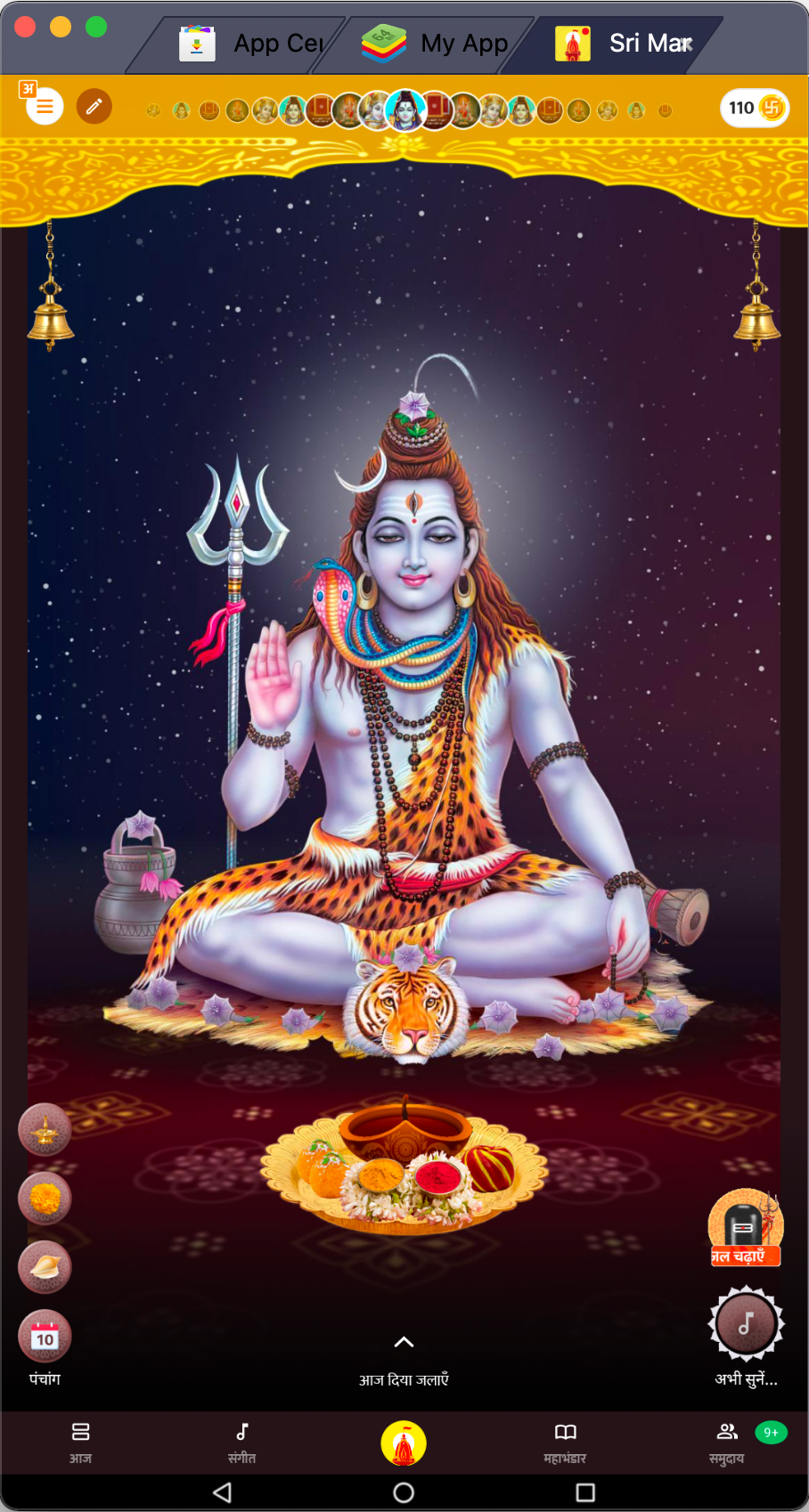
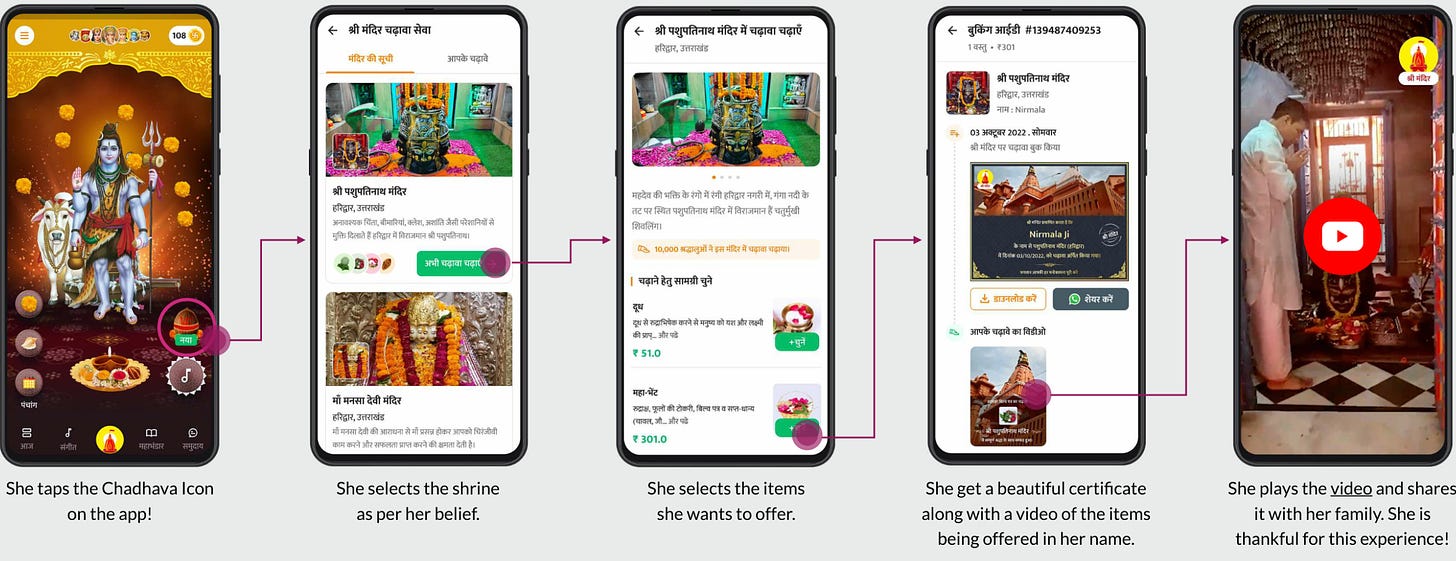


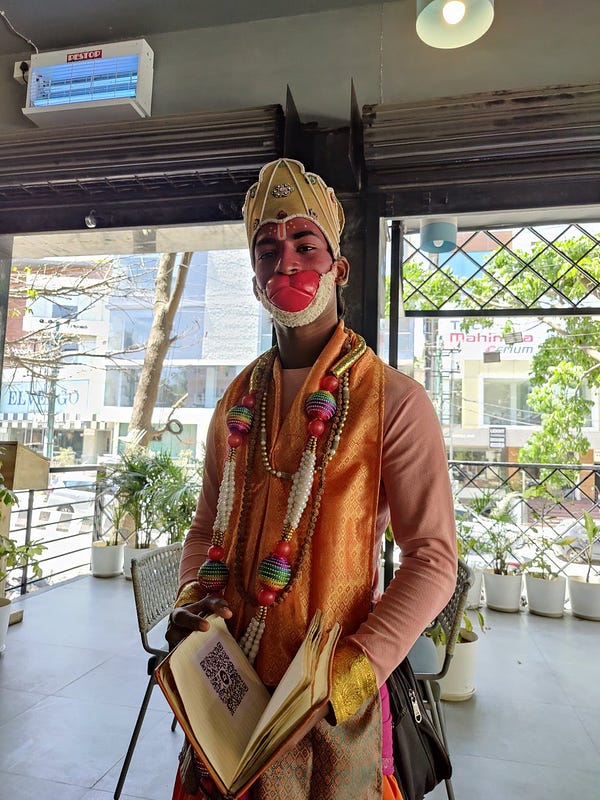
Hey Aaryaman, kudos on a well rounded and a thought-provoking write up of the app as well as the potential of this industry.
Is it possible add some source links at the end of the article for some of the facts/data mentioned?
Also, how long does it take for the user to get their chadhava video once they have made their payment?
Lovely in depth article aaryaman. Thank you. Would like to know what is the source of the "An industry estimate of the annual Hindu religious spending patterns" data? Thanks